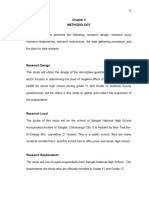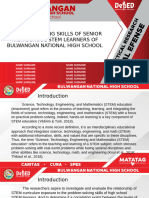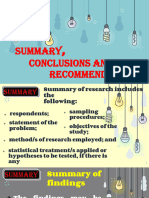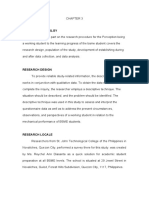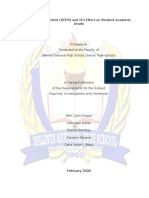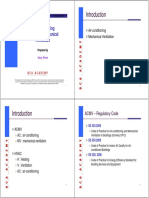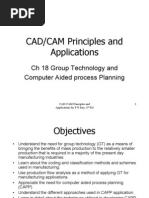Chapter Three
Chapter Three
Uploaded by
Rosebel RedubladoCopyright:
Available Formats
Chapter Three
Chapter Three
Uploaded by
Rosebel RedubladoOriginal Title
Copyright
Available Formats
Share this document
Did you find this document useful?
Is this content inappropriate?
Copyright:
Available Formats
Chapter Three
Chapter Three
Uploaded by
Rosebel RedubladoCopyright:
Available Formats
CHAPTER THREE
RESEARCH METHODOLOGY
This chapter presents the methodology to be employed by
the researcher. It indicates the description of the
research design, the respondents of the study, research
environment, the instrumentation to be used in gathering
the data, instruments’ reliability and the statistical
tool of the data that will be applied by the researcher
to complete the study.
Research Design
The researcher will use a descriptive correlational
research design. Descriptive Correlational according to
Creswell (2012) a correlation is a statistical test to
determine the tendency or pattern for two (or more)
variables or two sets of data to vary consistently. The
purpose of correlational research is tp determine the
relationship among two or more variables.
Moreover, the researcher will use a experimental
design to discover the effects of jealousy and favoritism
in the academic performance of ICT student . Also this
will aim to identify. The aim of this research is to
determine the effects of jealousy and favoritism in
academic performance experienced in the school and to
reveal possible solutions to reduce academic jealousy and
favoritism. This will involve collection of research data
through a survey method from a researcher-made
questionnaire.
The research follows a Experimental design. According
to Frost (2022) an experimental design is a detailed plan
for collecting and using data to identify causal
relationships. Through careful planning, the design of
experiments allows your data collection efforts to have a
reasonable chance of detecting effects and testing
hypotheses that answer your research questions. In this
study incompetence,inner failure, competitions, and
personal reasons will determine up to what extent it
influenced the academic performance of the Grade 11 ICT
students. Data will be collected from the Grade 11
students of San Juan City Technical Vocational and
Livelihood Senior High School.
Research Respondents
The researchers will ask the participation of randomly
selected Grade – 11 and 12 students of San Juan City
Technical Vocational and Livelihood Senior High School.
The researchers decided to collect participants on the
above mentioned group / grade level because on the
concern of jealousy and favoritism. The population of the
Grade 11 students in San Juan City Technical Vocational
and Livelihood Senior High School is [---]. The required
sample size is [---] as stated from the Krejcie and
Morgan Table, following a 95% confidence value and 5% on
the Margin of Error. Variables to be considered with the
students are incompetence, inner failure, competitions
and personal reasons.
Population and Sampling Scheme
The respondents of the study are the Grade 11 and
Grade 12 ICT students of San Juan City Technical –
Vocational and Livelihood Senior High School. For the
school year 2022 – 2023,this strand is being studied by
140 students in grades 11 and 12, equally.
Simple random sampling will be used in order to gather
the whole representative of the population. According to
Thomas(2020)simple random sampling is a type
of probability sampling in which the researcher randomly
selects a subset of participants from a population. Each
member of the population has an equal chance of being
selected. Data is then collected from as large a
percentage as possible of this random subset.
Table No. 1
Summary Table of the Respondents of the Study
Total Slovin’s Formula and Total
Population the Solution Sampling
Grade 11 and
12 - Senior
High School of N
Grade 11 n=
San Juan City 1+ N e 2
Technical
and 12 - 103
Vocational and 140
140 n=
Livelihood 1+(140)¿ ¿
Senior High
School
Research Environment
The respondents of the study are the Senior High
School Students of San Juan City Technical Vocational
Senior High School. In San Juan, this public senior high
school has a reputation for producing brilliant students
with a variety of abilities, including animation,
cooking, caregiving, etc. The fact that everyone in the
group is closest to this location and that all of the
researchers feel comfortable engaging with the local
population makes it the ideal location for conducting our
research, making the collection of data even easier.
Research Instrumentation
The researchers will use one instruments to gather all
the data - a researcher made survey questionnaire. This
is a experimental research, where the independent
variable has not yet occurred. The researchers will
collect the responses of of Grade 11 and 12 S.Y 2021-2022
from the survey questionnaire - it is posted in google
form.
Table No. 2
Scaling for the Interpretation of Questionnaire
Numerical Scale Statistical Limit Verbal Description
5 4.50 - 5.00 Always
4 3.50 - 4-49 Often
3 2.50 - 3.49 Rarely/Seldom
2 1.50 - 2.49 Sometimes
1 0.50 - 1.49 Never
Reliability and Validity of the Instrument
The instrument was pretested to 10 non respondent of
the study for the 10 day period to determine its
reliability. The results of the result will be the Pre-
test. After a period of two (2) weeks, the same test will
again be administered to the same sets of students and
the result will be the Post-test.
Data Gathering Procedure
After the reliability test of the instruments to be
determine, the researchers will ask permission from the
Principal of San Juan City Technical Vocational and
Livelihood Senior High School for a the list of Grade 11
and 12 senior high school student who are enrolled in S.Y
2022-2023 and from the advisers of the sections to
conduct the test.
The set of questionnaire will be distributed by
sending a URl to the respondents to clearly explain each
item and its direction very well. The students will have
15 to 20 minutes only in answering the survey
questionnaire. The researcher will instantly collect the
responses of the respondents.
Statistical Treatment
The data will be gathered to analyze and interpret and
testing the hypothesis of the study using descriptive
statistics such as frequencies, mode and percentages.
Internal consistency will also be used to determine
the reliability of the instruments. These tools will help
the researcher to analyze and interpret the results.
The following statistical tool formula to be used in the
study.
Internal Consistency - Cronbach’s Formula
N .c
α=
v +( N − 1). c
Where
N = the number of items
c = average covariance between item pairs
v = average variance
Evaluative Statement
Objective: To determine the effects of jealousy and
favoritism in the academic performance of Grade 11 and 12
students in San Juan City Technical Vocational and
Livelihood Senior High School.
Respondents: Grade 11 and 12 students of San Juan City
Technical and Vocational Livelihood Senior High School.
You might also like
- Oral Defense Powerpoint Template QuantiNo ratings yetOral Defense Powerpoint Template Quanti21 pages
- CHAPTER 3 RESEARCH METHODOLOGY GROUP 5.CHECKED AND EDITEDNo ratings yetCHAPTER 3 RESEARCH METHODOLOGY GROUP 5.CHECKED AND EDITED5 pages
- Summary Conclusion and Recommendation PR2No ratings yetSummary Conclusion and Recommendation PR238 pages
- Thesis Title Chapter 3 NEW (03-23-2020)No ratings yetThesis Title Chapter 3 NEW (03-23-2020)10 pages
- THE FINANCIAL CHALLENGES FACED BY SENIOR HIGHSCHOOL STUDENT CHAPTER 3No ratings yetTHE FINANCIAL CHALLENGES FACED BY SENIOR HIGHSCHOOL STUDENT CHAPTER 33 pages
- Code-Switching Attitudes and Practices and The Student'S Academic Achievement in English Research MethodologyNo ratings yetCode-Switching Attitudes and Practices and The Student'S Academic Achievement in English Research Methodology10 pages
- Central Philippines State University Graduate SchoolNo ratings yetCentral Philippines State University Graduate School6 pages
- Group 1 Research Guide - Chapter 1-3 FinalNo ratings yetGroup 1 Research Guide - Chapter 1-3 Final9 pages
- Strand Mismatched (STEM) and It's Effect On Student Academic GradeNo ratings yetStrand Mismatched (STEM) and It's Effect On Student Academic Grade28 pages
- AESTHETIC-COQUETTE-RIBBON-CHAPTER-2-LABUBU-MONKEYS-PR2No ratings yetAESTHETIC-COQUETTE-RIBBON-CHAPTER-2-LABUBU-MONKEYS-PR29 pages
- Impact Assessment of Stem Initiatives in Improving Educational Outcomes: Research Report from a National Evaluation Conducted to Inform Policy and PracticeFrom EverandImpact Assessment of Stem Initiatives in Improving Educational Outcomes: Research Report from a National Evaluation Conducted to Inform Policy and PracticeNo ratings yet
- NPS Transaction Statement For Tier I Account: Current Scheme PreferenceNo ratings yetNPS Transaction Statement For Tier I Account: Current Scheme Preference4 pages
- SDip - ME102 - Coord - 2015a - Rev - 25 - May - 2015 (ACMV)100% (1)SDip - ME102 - Coord - 2015a - Rev - 25 - May - 2015 (ACMV)37 pages
- Melaka Sentral, Malacca Simpang Taiping, Taiping: Total Amount: MYR 41No ratings yetMelaka Sentral, Malacca Simpang Taiping, Taiping: Total Amount: MYR 411 page
- Features: Fanless Embedded Box PC With Socket Type 6th Generation Intel® Processor and Q170 ChipsetNo ratings yetFeatures: Fanless Embedded Box PC With Socket Type 6th Generation Intel® Processor and Q170 Chipset2 pages
- Sievers Certified Reference Materials and Consumables CatalogNo ratings yetSievers Certified Reference Materials and Consumables Catalog32 pages
- Publish To The World: Agama Rahasyam PDFNo ratings yetPublish To The World: Agama Rahasyam PDF3 pages
- Descriptive Study To Assess The Effectiveness of Structured Teaching Programme On Prevention of Myocardial Infarction Among Employees Selected Hospital of Gwalior MPNo ratings yetDescriptive Study To Assess The Effectiveness of Structured Teaching Programme On Prevention of Myocardial Infarction Among Employees Selected Hospital of Gwalior MP3 pages
- Chapter 18 Group Technologyand CADPlanningNo ratings yetChapter 18 Group Technologyand CADPlanning25 pages
- The Man With His Back Turned: by Agustín CadenaNo ratings yetThe Man With His Back Turned: by Agustín Cadena2 pages
- Isolation of Bacteriophages From Sewage SludgeNo ratings yetIsolation of Bacteriophages From Sewage Sludge6 pages
- Download ebooks file The Sociology of Time: A Critical Overview Jiří Šubrt all chapters100% (6)Download ebooks file The Sociology of Time: A Critical Overview Jiří Šubrt all chapters51 pages
- ZRC GALVILITE Galvanizing Repair CompoundNo ratings yetZRC GALVILITE Galvanizing Repair Compound2 pages
- Special Issues On International Law GancNo ratings yetSpecial Issues On International Law Ganc55 pages
- CHAPTER 3 RESEARCH METHODOLOGY GROUP 5.CHECKED AND EDITEDCHAPTER 3 RESEARCH METHODOLOGY GROUP 5.CHECKED AND EDITED
- THE FINANCIAL CHALLENGES FACED BY SENIOR HIGHSCHOOL STUDENT CHAPTER 3THE FINANCIAL CHALLENGES FACED BY SENIOR HIGHSCHOOL STUDENT CHAPTER 3
- Code-Switching Attitudes and Practices and The Student'S Academic Achievement in English Research MethodologyCode-Switching Attitudes and Practices and The Student'S Academic Achievement in English Research Methodology
- Central Philippines State University Graduate SchoolCentral Philippines State University Graduate School
- Strand Mismatched (STEM) and It's Effect On Student Academic GradeStrand Mismatched (STEM) and It's Effect On Student Academic Grade
- AESTHETIC-COQUETTE-RIBBON-CHAPTER-2-LABUBU-MONKEYS-PR2AESTHETIC-COQUETTE-RIBBON-CHAPTER-2-LABUBU-MONKEYS-PR2
- Impact Assessment of Stem Initiatives in Improving Educational Outcomes: Research Report from a National Evaluation Conducted to Inform Policy and PracticeFrom EverandImpact Assessment of Stem Initiatives in Improving Educational Outcomes: Research Report from a National Evaluation Conducted to Inform Policy and Practice
- NPS Transaction Statement For Tier I Account: Current Scheme PreferenceNPS Transaction Statement For Tier I Account: Current Scheme Preference
- SDip - ME102 - Coord - 2015a - Rev - 25 - May - 2015 (ACMV)SDip - ME102 - Coord - 2015a - Rev - 25 - May - 2015 (ACMV)
- Melaka Sentral, Malacca Simpang Taiping, Taiping: Total Amount: MYR 41Melaka Sentral, Malacca Simpang Taiping, Taiping: Total Amount: MYR 41
- Features: Fanless Embedded Box PC With Socket Type 6th Generation Intel® Processor and Q170 ChipsetFeatures: Fanless Embedded Box PC With Socket Type 6th Generation Intel® Processor and Q170 Chipset
- Sievers Certified Reference Materials and Consumables CatalogSievers Certified Reference Materials and Consumables Catalog
- Descriptive Study To Assess The Effectiveness of Structured Teaching Programme On Prevention of Myocardial Infarction Among Employees Selected Hospital of Gwalior MPDescriptive Study To Assess The Effectiveness of Structured Teaching Programme On Prevention of Myocardial Infarction Among Employees Selected Hospital of Gwalior MP
- Download ebooks file The Sociology of Time: A Critical Overview Jiří Šubrt all chaptersDownload ebooks file The Sociology of Time: A Critical Overview Jiří Šubrt all chapters









